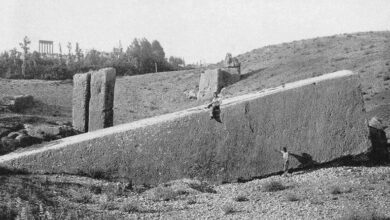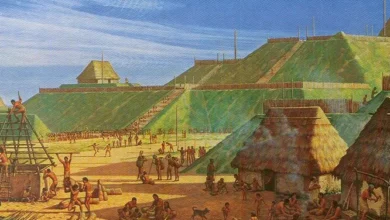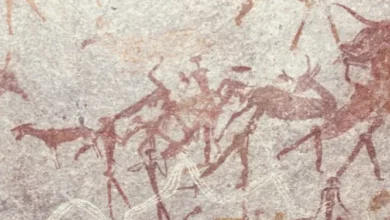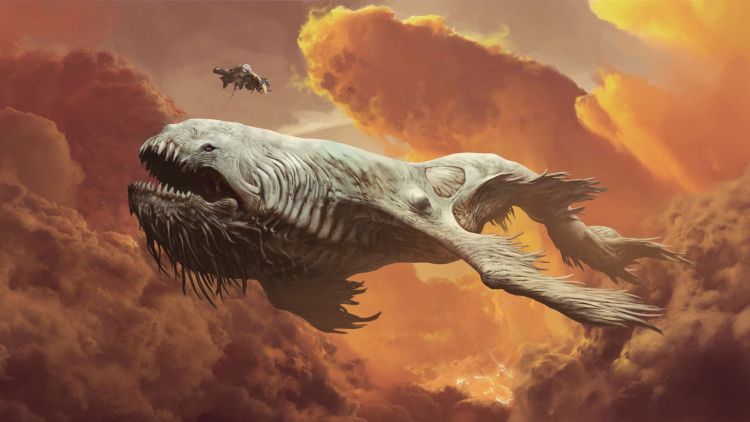
Who is Leviathan and why did he have an uncontrollable passion to sink ships
(ORDO NEWS) — The whales plowing the modern ocean expanses are undoubtedly huge, intelligent creatures that attract our imagination. They follow their course in search of plankton or squid. Animals are smart, treat their offspring with care, and sometimes come to the aid of people who find themselves in a difficult situation in the water. But in ancient times, the conditions of existence on the planet were much more stringent. And among the cetaceans there were many examples of the terrifying appearance of predatory hulks. One of these was Melville’s Leviathan, the most dangerous toothed whale in existence.
Origin story
The image of a many-headed sea monster named Latanu, or Leviathan, appears in the mythology of the ancient city-state of Ugarit, which existed on the territory of modern Syria six thousand years BC. There the leviathan accompanied Yam, the god of the sea, and was defeated along with that god Baal.
Later, the image of the Leviathan penetrated the legends of the ancient Jews. It is believed that this image came from Egypt. The Jews interpreted in this way the information about the crocodiles living in the Nile River.
Described and retold many times by those who have never seen a live crocodile, the image could be significantly distorted. In addition, the animal’s size and power could be “artistically exaggerated” for intimidating effect. As a result, the animal has changed almost beyond recognition in the minds of the people, turning into a demon from fiery hell.
Leviathan
The name Leviathan is mentioned in the Tanakh and in the oldest part of the Christian Bible - the Old Testament. There, this name means “twisted”, “twisted”, and in modern Hebrew it is translated as “whale”.
Leviathan - the beast from the biblical story
The parables mention that the Lord created each creature in pairs. However, there were beings created in a single kind. Perhaps this is a reflection of ancient myths about sea and earth creatures, real monsters. Such legends are found all over the world, and the Semitic peoples who became the ancestors of the Bible are no exception.
Leviathan is a sea beast of unprecedented strength and size. It is described in detail in the book of Job, where the Lord explains his plan for its creation. His appearance is also partially indicated there: he has two jaws, a huge body covered with the strongest scales, fire-breathing and capable of evaporating the seas. At the same time, contrary to later sources, it is separately noted that the monster itself does not belong to demons or hellish forces, but is only a manifestation and symbol of the unlimited power of the Lord.
Old Testament books and parables report that there were two such beasts. The second is Behemoth, whose name the demon was later named. They are described as creatures of God that no weapon, mortal or angel, can handle. It is believed that it is impossible to catch, subdue and kill these creatures. They will die only during the Last Judgment, killing each other, and the saved righteous will feast on their meat.
Book of Job
The legend described in the Book of Job reflects how a person should perceive God’s will. The mention of Leviathan in it is just one of the examples in the conversation between man and the Lord. The Creator reminds Job that there are creatures and phenomena on earth that are beyond the control of man. Murmuring against fate and complaining about the injustice of God is like trying to defeat the sea monster Leviathan. When Job stops arguing and recognizes the righteousness of the Lord, he dies in peace and quiet, as he wanted.
The ship collided with a sea serpent. In this story, the Leviathan is described most fully. Based on the biblical text, we can learn that:
- Leviathan is incredibly huge;
- his power is beyond description;
- he is harmed by no human weapon;
- he himself easily breaks chains and breaks iron;
- when meeting with him, a person experiences horror;
- from contact with his body, water boils;
- he knows no fear, and this is the true king of beasts.
The power and ability of the leviathan serves as a reminder to Job of how great God is, and how useless and stupid it is to try to argue with him.
Book of Isaiah
Leviathan is also mentioned in the Book of Isaiah. And here the leviathan is presented not as a mythical, but a real creature. This is the serpent that the Lord will strike with his sword on the appointed day. Despite the fact that the creature lives in the sea, the leviathan is called “a straight-running serpent” and “a writhing serpent.” It is difficult to determine whether we are talking about two different leviathans or about one monster that will be defeated in any case.
Fact! Leviathan, struck by the sword (or lightning) of the Lord, is seen as an allegory of the wicked nations that he will one day punish. But there is no direct indication of this in the text of the Bible. In the Book of Isaiah, Leviathan acts as a reminder that no one will escape God’s wrath if he provokes it. Even such a strong and powerful creature will easily perish if the Lord so desires. In the Christian and Jewish religions, leviathan becomes a constant reminder of the power of the Lord.
Psalm 73 echoes the Book of Isaiah. It says that the Lord will smite the monster from the ocean. Conversely, in Psalm 104 God is praised for the vast expanses of the sea where the leviathan lives and frolics.
How many leviathans are there?
In addition to who Leviathan is, there are still a number of ambiguities in the Bible. The name of the animal is mentioned either in the singular or in the plural, i.e. it is impossible to determine for sure whether it was a unique immortal beast, or whether it was a whole species of animal.
Several versions have been put forward by interpreters of sacred texts on this score:
- this is a real-life species of animals, possibly extinct;
- these are a few individuals that exist under the strict control of the Lord (perhaps the last individuals of an extinct species that man found);
- the only individual that exists as a symbol of divine power (male).
Supporters of the latest version put forward two opposite opinions. First, the Lord originally created only the male. The second is that he created two underwater dragons, a male and a female, but then destroyed the female so that the leviathan could not breed.
Infernal essence of the master of the seas and oceans
Due to the fact that the ocean monster had incredible strength and abilities, many ancient scientists attributed it to demons. And Binsfeld, a popular scientific researcher in the 16th century, completely raised the lord of the water depths to the same level as the fallen angel Lucifer. Also in ancient times it was believed that Leviathan was one of the essences of the devil, his animal display.
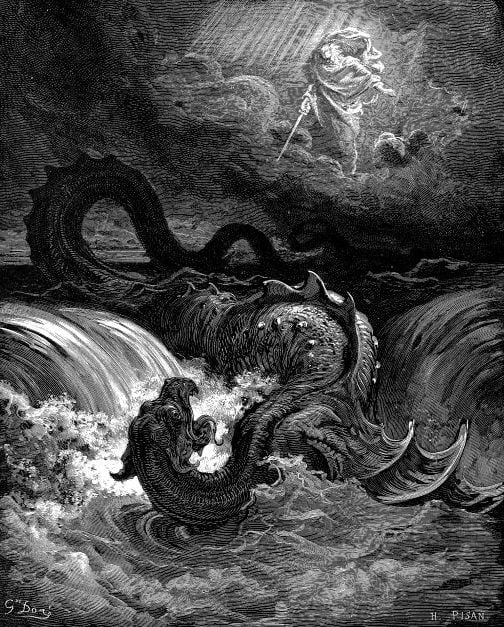
An interesting fact is that the images of the lord of the oceans did not appear in one of the most famous grimoires - the Keys of Solomon (the contents of which can be found on Wikipedia, here you can also see a reconstructed photo of the underwater monster itself). There is not a single mention in scripture that anyone could be possessed by an unclean one who would bear a name identical to the lord of the seas. Therefore, it can be seen that many of the ancients, after all, did not consider the water monster a demon.
In the modern world, the monster Leviathan is considered a monster from the water depths, the lord of the ocean. He is not elevated to either angels or demons, he does not participate in the war between God and the devil. God’s creature lives in the depths of the sea and guards its possessions. This sea monster is also found in modern culture. For example, there is a film of the same name that tells about a soulless, immortal bureaucracy. One of the seasons of the popular series “Supernatural” is dedicated to this waterfowl horror. Also associated with the word “Leviathan” is something that does not have a soul, and that cannot be defeated. Today, there are even some cults that worship the lord of the water expanses, but the number of these cults is negligible.
History of Leviathan and parallels with other nations
The first mention of Leviathan comes to us from the ancient Semitic texts and myths of Egypt. It was believed that from the east it was protected by crocodiles living in the Nile - legends about these creatures reached Mesopotamia and the ancestors of the Jewish peoples, where they could transform into the appearance of Leviathan. A similar beast is also mentioned in ancient Babylonian legends. In them, the god Baal became the only one who could defeat the most powerful servant, the personal monster of the god of the sea named Yama.
An interesting parallel can be traced in the image of Leviathan with Scandinavian mythology - it is also believed that a huge boar lives in Asgard, the meat of which is eaten every evening by warriors who died in battle. This coincides with the parable of Leviathan and the righteous who will eat it after the Judgment. Another reference to the myths of Scandinavia is the serpent Jormungandr - the same sea monster. And the scene of the Last Last Judgment itself, in which mythical beasts will fight, is very similar to Ragnarok - the end of the world.
Leviathan is compared with the ancient Greek creatures Scylla and Charybdis or the Lernaean Hydra. And in ancient Russian mythology, this image was borrowed by the Miracle Yudo, known from many fairy tales. There are analogues of powerful sea creatures with similar features in almost all world religions and traditions.
According to scientists, in the Middle Ages and in antiquity, sea animals were often confused with Leviathan - whales, sperm whales, killer whales, giant squids and even walruses. This has left an imprint on some animal names in Latin. And in modern culture, it is often identified with something soulless and invincible - a ruthless machine of bureaucracy and mutual responsibility, as demonstrated in the film of the same name.
The origins of the image
Having studied several different sources with legends about Leviathan, I considered it necessary to turn to the origins of the image of this beast. According to many historians, myths are based on ancient Semitic legends and myths of ancient Egypt.
As it was believed in the distant past, the guardians of the lands of these peoples were crocodiles. Tales about them often emphasized the divine origin of these predators, and, having reached Mesopotamia, the stories about crocodiles were transformed into a “portrait” of Leviathan.
In addition, some details of the image of Leviathan are incredibly reminiscent of fragments from Scandinavian legends. In the myths of Scandinavia there is a mention of a huge boar, the meat of which is eaten every day by warriors, whose glorious deeds have found their recognition even in Asgard.
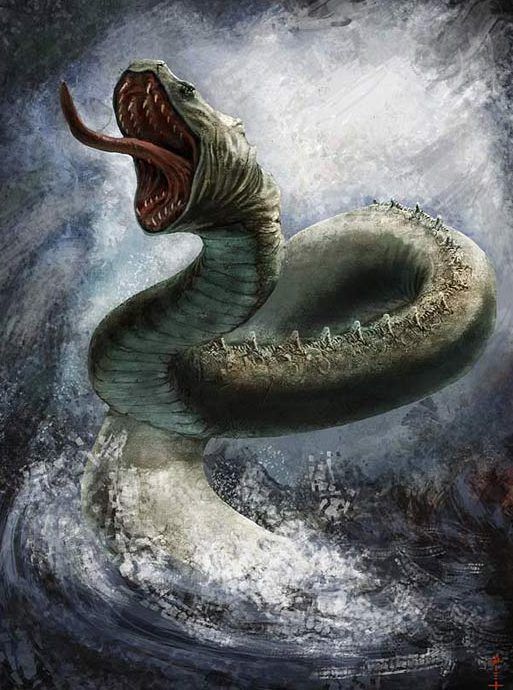
By the way, I would like to separately mention the snake Jormungand, who lived in the depths of the sea. No less famous were the sea monsters that the ancient Greeks believed in - Scylla and Charybdis. But they act as formidable and destructive creatures for humans, a product of the gloomy depths, and not a divine creation.
In traditions, there was also such a sea monster - Miracle Yudo. It is possible that the collective features of various creatures known among various peoples found a place in the image of Leviathan.
Researchers believe that Leviathan could have been “born” in the ancient city-state of Ugarit, which existed on the territory of modern Syria. According to ancient legends, the sea monster acted as an assistant to the god Yam, who was cast into the abyss by the great deity Baal.
Secrets of Leviathan
But why didn’t God create a couple for Leviathan, leaving the animal alone? As the biblical texts tell, the plan of the Lord was extremely simple: to create living beings that could multiply, settling on the earth.
Some of the legends note that a female was first created for Leviathan, but God immediately realized how dangerous the appearance of several such animals in the world would become. That is why the Lord destroyed all the females of this species, leaving Leviathan without a mate. Of course, this mythological act says a lot and, first of all, emphasizes the power of the animal.
The image of Leviathan has become very popular in literature and cinema, it is successfully used in our time. Particularly interesting are the metaphorical interpretations of this monster. For example, in the film of the same name by Andrei Zvyagintsev, Leviathan symbolizes state power.
Leviathan is no less popular with modern science fiction writers. American Scott Westerfeld used the name “Leviathan” for a flying ship that performs a special mission.
In the book cycle “Seven Beasts of Rayleigh” by Nika Perumov, Leviathan is described as one of the animals and, admittedly, the image turned out to be very interesting and colorful. The famous book hero of Boris Akunin, Erast Fandorin, was also connected by a storyline with the Leviathan ship, on which inexplicable things happened.
What is the reason for the popularity of the image of creation, which was written about many centuries ago? In my opinion, Leviathan is attractive for its power. The scriptures say that no one can defeat him, but it is specified that during the Last Judgment, Leviathan will fall at the hands of the archangel Gabriel or die himself. Here it is - an image of power and greatness, which still cannot be infinitely strong and administering power.
Other animals similar to Leviathan
In the mythologies of many ancient peoples, there are references to large sea monsters. All of them have different names, but have several common features. This is a huge size, physical strength, invulnerability to weapons and lack of intelligence. The beast always terrifies people, but is not able to show aggression on its own. He attacks ships on the orders of his master, if he has one, or fights other powerful forces, and people become random victims.
Scientists are still arguing about the real prototypes of sea demons. Perhaps we are talking about large marine animals, including extinct ones. People could not see the underwater inhabitant, they saw only certain parts of his body and guessed the rest, hence the unrealistic descriptions. On the other hand, ancient people were inclined to animate natural phenomena, including endowing them with animal traits. According to this version, the leviathan and sea creatures similar to it are an animated storm in which people saw a huge reptile or fish.
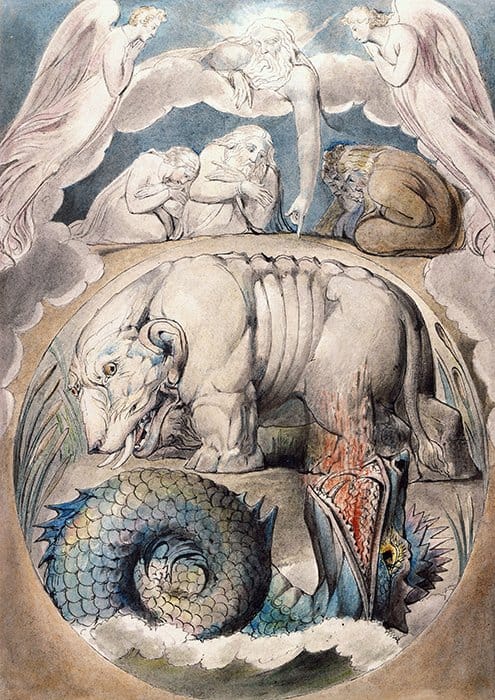
In the myths of the ancient Scandinavians, Jörmungandr is a sea serpent that encircles the earth. He was born to Loki along with two other monsters - the wolf Fenrir and the giantess Hel. Odin took his children from Loki and tried to destroy him, but could not. He threw Jormungandr into the ocean, where the serpent not only did not die, but also began to grow rapidly. He grew to a huge size, embraced the whole earth with his body and clung to his own tail. In this he is similar to another snake - Ouroboros.
Scandinavian sailors explained storms and earthquakes by the behavior of the World Serpent. In the legends, references to the struggle of the Serpent with the gods have been preserved. He had a particular dislike for Thor. During the last battle of the world - Ragnarok, two eternal opponents must come together in battle and die.
Typhon and Zeus
In ancient Greece and other countries of the Mediterranean, the legend of Typhon was widespread. This is a snake-like monster, or a giant with snakes instead of legs. He was the son of the very first goddess Gaia and Tartarus, or was created by the Hero from an egg (option - she was born to her without the help of her husband). It was a gigantic creature that fought the gods.
During a long battle with the gods, Typhon met with another offspring of Gaia and Tartarus - Echidna. She was also half-woman, half-dragon or dragon. From this union, the most powerful monsters of Greek myths were born, which left a noticeable mark on the culture of antiquity (Cerberus, the Nemean Lion, the Lernean Hydra, the Sphinx).
Fact! Presumably the word “Typhoon” was the result of a merger of two words. Chinese borrowing “Tai feng”, i.e. “storm”, “great wind”, and the name of the Greek monster Typhon.
The confrontation between Typhon and Zeus ended with the victory of the Thunderer. He threw the snake to the ground and threw stones from above, and put the volcano Etna on his head. Ancient Greek religion explained earthquakes and volcanic eruptions as Typhon’s attempts to free himself.
Kraken
Icelandic sailors called the kraken an underwater monster that looks like a giant squid. According to various legends, the kraken either obeys the king of the sea, or is the embodiment of the sea element and does not have a master. He attacks ships on the high seas, sinks them and destroys the crew. He can appear in a storm or, conversely, in good weather and calm water without any signs.
If there were a meeting between two sea monsters, it would be difficult to determine who is stronger - the kraken or the leviathan. According to the descriptions, the kraken has huge tentacles of incredible strength, and the scales of the leviathan cannot be pierced. Both are great underwater and on the surface, and both have tremendous destructive power. It would be a battle of the titans, which a person would hardly be able to see and remain unharmed.
Leviathan - a monster in culture and art
In culture and art, the leviathan has become a symbol of any phenomenon that amazes with its scale. An animal, a natural phenomenon, a society or a people can be compared with this creature. In R. Abernathy’s story “The Man Against the City” the city is compared to a leviathan. This city is huge, cruel and completely indifferent to the hero. But he is not devoid of the rudiments of his own mind (or so it seems to the hero). Also in fantasy books, the name Leviathan is often used as the name of large sea creatures in the service of man.
In the writings of T. Hobbes, the state apparatus is compared with the leviathan. It appears as a system devouring human individuality and creativity. At the same time, the state demon leviathan is too huge for one person or a group of people to cope with it.
Film “Leviathan”
One of the most discussed film creations associated with the name of the sea monster is the film Leviathan (directed by A. Zvyagintsev). It incorporates the biblical story of Job and the works of Hobbes, who compares the state with this monster.
According to the plot, the main character repeats the path of the biblical Job - he loses everything he had, but does not come to terms with it and does not bless the Lord. He fights, but attempts to confront the mayor of the city, corrupt judges and indifferent people are hopeless. He loses his house, breaks up with his wife, who dies immediately after a quarrel, and goes to prison for crimes he did not commit. Only the cold northern sea, where the mythical monster Leviathan lives, knows the answer to what really happened.
The film received mixed reviews from domestic critics. One of the main complaints is the use of booze, chanson and swear words on the screen. The main advantage is considered to be a unique filming location - the shore of the Barents Sea. Photos from the filming of Leviathan turned out to be extremely picturesque.
The series “Supernatural”
In the Supernatural series, leviathans are the most powerful monsters that the heroes have to face. Within the framework of the series, these creatures can change their appearance and look like anything, including pretending to be human. They were created by some of the first living creatures, and no man, monster or angel can harm them. To prevent the leviathans from destroying all life, God placed them in purgatory.
Only God and archangels can kill such monsters. They can also kill each other and devour themselves. Another weakness is their dependence on the leader. The elder monster has ruled since the creation of monsters, and when the heroes manage to kill him, the leviathans lose much of their power. Then they appear in the memories of the heroes.
Sergei Khudiev on the Bible, Hobbes and Leviathan
Judging by the messages on Facebook, the great and mighty Russian language has been enriched with a new curse - “shameful leviathans”, in the sense of “alcoholics who disgrace our country to the whole world.” This is due to the new film directed by Andrei Zvyagintsev called “Leviathan”, which depicts the horrors of the Russian hinterland. I didn’t watch the film - the director himself urged not to watch pirates, and I’ll hardly get to the cinema - therefore I can’t join either the choir of his scolds or the anti-choir of defenders, I only note that making films about the hopelessness of life in the French / German / Dutch or some other hinterland is a common thing for European directors.
Here I would like to consider a little the very image of Leviathan - because it is quite firmly present in European culture. He appears in the Holy Scriptures, in the book of Job, in the form of a mighty sea monster:
“Can you draw Leviathan with a fishhook and grab hold of his tongue with a rope? .. The circle of his teeth is horror; his strong shields are splendor; they are sealed, as it were, with a firm seal; one touches the other closely, so that even the air does not pass between them; one with the other lie tightly, grappled and do not move apart. His sneezing shows light; his eyes are like the eyelashes of the dawn; flames come out of his mouth, fiery sparks jump out; smoke comes out of his nostrils, as from a boiling pot or cauldron. His breath kindles coals, and a flame comes out of his mouth. Strength dwells on his neck, and terror runs before him. The fleshy parts of his body are firmly united among themselves, do not flinch. His heart is as hard as stone and as hard as the bottom millstone. When he rises, the strong men are in fear, completely lost in horror. The sword that touches him will not stand, neither the spear, nor the javelin, nor the armor. He regards iron as straw, copper as rotten wood. He boils the abyss like a cauldron, and turns the sea into a boiling ointment; leaves behind a luminous path; the abyss looks gray. There is no one like him on earth; he is made fearless; looks boldly at everything high; he is king over all the sons of pride” (Job 40-41)
Leviathan is an image of all-destroying power, in which sometimes a demonic shade appears in Scripture; Leviathan is a monster that will be crushed by God: “In that day the Lord will strike with His heavy sword, and great and strong, Leviathan, the straight-running serpent, and Leviathan, the curving serpent, and will kill the monster of the sea” (Is. 27: 1)
However, Leviathan gained great fame thanks to the famous book of the 17th century English thinker Thomas Hobbes, where it is a symbol of the state:
“In this Leviathan, the supreme power, which gives life and movement to the whole body, is an artificial soul, officials and other representatives of judicial and executive power - artificial joints; reward and punishment (by which every joint and limb is fastened to the seat of sovereignty, and impelled to do its duty) are the nerves which perform the same functions in the natural body; the welfare and wealth of all private members is his strength, salus populi, the security of the people, is his occupation; the advisers who inspire him with everything he needs to know are memory; justice and laws are artificial reason (reason) and will; civil peace is health, turmoil is disease, and civil war is death.
Hobbes, who witnessed the English Civil War, emphasized the need for a state, without which society falls into a state of war of all against all:
Read also Who is Lilith from the Bible? “As long as people live without a common power that keeps them all in fear, they are in that state called war, and precisely in a state of war of all against all … Let the doubter himself reflect on the fact that, setting off on a journey, he arms and tries to go in a big company; that when he goes to bed he locks the doors; that even in his house he locks the drawers, and this when he knows that there are laws and armed representatives of the authorities, ready to avenge any injustice done to him. What opinion does he have of his fellow citizens when he locks his doors, of his children and servants when he locks his drawers? Doesn’t he just as much blame the human race by his actions, like my words?” The image of Leviathan in Hobbes is somewhat ambivalent - it is not the most pleasant of animals, but its existence is absolutely necessary, otherwise society plunges into chaos. The German thinker and poet Friedrich Nietzsche, without calling Leviathan by name, clearly refers to the image taken from Hobbes in his poem “Thus Spoke Zarathustra”:
“The state is called the coldest of all cold monsters. It lies coldly; and this lie creeps out of its mouth: “I, the state, am the people” … But the state lies in all languages about good and evil: and what it says, it lies - and what it has, it stole. Everything in it is fake: it bites with stolen teeth, toothy. Even his womb is fake”
For Andrey Zvyagintsev, the director of the film of the same name, this image is obviously important - the power that an individual person cannot resist. Individual people can be like some kind of sea monster - and sin can take on not only a personal, but also a collective character.
The very name of Leviathan refers to a certain tradition of thinking about the human lot, about the individual and the state, about personal and public sin - and sets a fairly high bar for these thoughts. Reacting to these thoughts in the style of “enemies want to offend us!” is probably not worth it anyway.
—
Online:
Contact us: [email protected]
Our Standards, Terms of Use: Standard Terms And Conditions.

